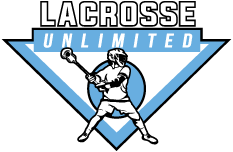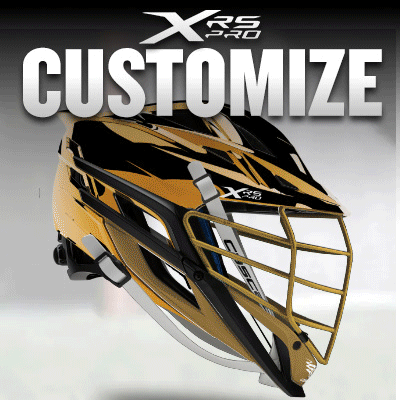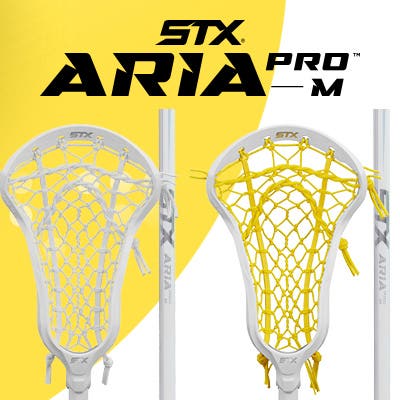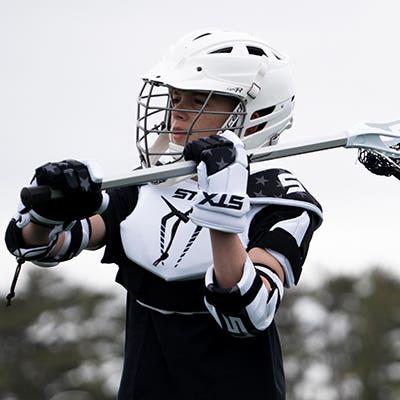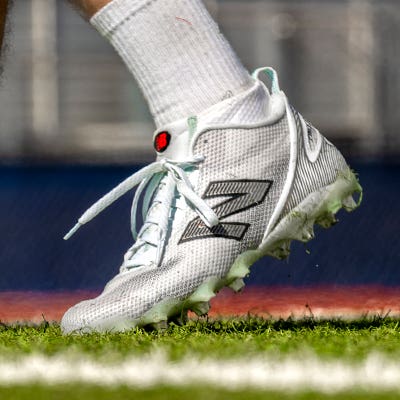
Okay, so you’ve evaluated your players, you’ve studied the offensive sets, and you’ve decided to run the 1-3-2 (if not, check out our article laying out the offensive sets here). Let’s move into some plays and functions of the 1-3-2 to help increase your team’s offensive efficiency and chances of success.
You’ll notice in the diagram we have created for you that this formation creates 2 triangles, one between the three middies, and one between the three attackmen. These triangles are going to be structures that each player wants to maintain through dodges, motion and rotation. Simply put, if one player dodges, the adjacent player will replace them, and so on. You always want to try to maintain the structure of the offense because it makes the defense rotate with you, and also helps maintain outlet passes for dodging players.
You can initiate the offensive motion from either the midfield or attack positions. In the diagram, you can see the rotation from the midfield position if M2 were to dodge down the alley. As they start to dodge down, M1 wants to bump over to replace them and act as a fallback pass if the adjacent attackman is locked off. M3 who started in the crease wants to start to rotate up to where M1 was. This will clear space in the crease and open up a shooting window for the dodger if they can beat their man, because the crease defender will have to play both M3 as a feed-able threat and M2 as a shooter if he beats his man.
The attackmen will also need to rotate as the middie comes down the alley. A3 will rotate across, taking their defender with them and creating space for M2 to dodge, eventually also becoming the backside look. A2 will rotate towards the dodger and act as a near post feed. The backside attackman, A1 in the diagram, can delay their rotation a bit so that they can serve as an early backside feed, but they will want to be sure to be able to back up the cage in case M2 shoots and misses, this way your team can retain possession.
At the bottom of M2’s dodge, they will have a few options: first they have the option to shoot if they beat their defender and have a window before the sliding defender gets to them. They can feed it to the backside or near side attackman if they are open for a dink and dunk high percentage shot. If the shot is not available, and both adjacent attackman are locked off, there are a few passing options. A2 can pop outside further towards the restraining line as an outlet, M1 will be open as a fail-safe option for a re-dodge, or a skip pass can be made to A1 at X after they complete rotation. While these last options may not lead to a score or scoring opportunity, sometimes it is best not to force, but to retain possession in order to get a higher percentage look. After M2 either shoots or passes, they will want to pop into the middle to replace M3 as the crease middie.
Dodging from the attack can be a bit more dynamic, as you can dodge from any attack position. The most common spot to dodge from is X, where A1 is. A1 can either go righty or lefty. The attackman they dodge towards will be rotating across the crease to the backside position, represented by A2 here. A3, the original backside attackman, will rotate down to X to back up any shots and act as adjacent support. Generally, you will want A1 to be one of your shiftiest, quickest players, because beating your opponent from X often leads to high percentage, on-the-crease shots.
The middies will also go through their rotation. The crease middie, M3, will want to clear out opposite of the dodging attackman in order to maximize the distance between the dodger and the sliding defender. They will become a through look for an open outside shot if the crease defender slides early to the dodger. The middie on the side that the attackman is dodging towards, M1 in the diagram, will cut down toward the crease and act as a feed for a close shot. The middie who starts opposite the dodge will rotate over and act as an adjacent pass for a step down outside shot, pictured by M2.
This offensive strategy is very effective with highly skilled dodging attackman and strong outside shooters by creating more space for through passes to the middies and for the attackman to dodge close to the net. Be sure to emphasize the importance of rotating and replacing your adjacent player’s position, because any miscommunications or incorrect rotations can lead to turn overs, which can crush offensive momentum.

